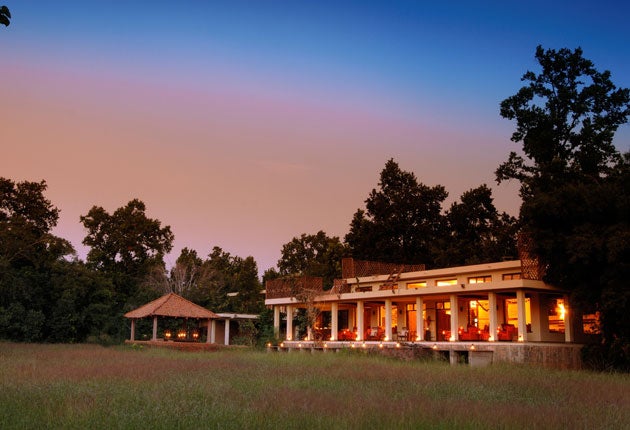Be realistic. It's rare to see a tiger in India
Sighting this mighty predator is a bonus. So, don't miss the rest while you're waiting, says Amar Grover

As India's wild tigers fight for survival, our desire to see them grows. More boutique lodges are opening in the heartland state of Madhya Pradesh – courtesy of Taj Safaris, a joint venture between Taj Hotels Resorts and Palaces and &Beyond.
Taj Safaris opened its first lodges just over two years ago at Bandhavgarh and Pench National Parks. Pashan Garh, the third lodge, launched at Panna in December 2008, and their fourth, Banjaar Tola, opened in February this year at Kanha.
Located in the eastern half of Madhya Pradesh, a state slightly larger than Italy, these four parks are among the best places in India to view tigers. Taj has adopted evocative African terminology for its offering: guests stay in a "safari lodge" and take "game drives" in high-backed open-topped safari vehicles. &Beyond uses its African method to improve the skills of government-employed Park guides and – as in Africa – it has launched community programmes to bring some benefits from this high-rolling tourism to local people.
But, unlike Africa, where visitors are almost guaranteed to see the Big Five – lion, elephant, buffalo, leopard and rhino – you will be lucky to see a tiger in India. I say this as a veteran of around 50 hours over three separate visits in eight years – with just two brief, yet exhilarating, sightings to my credit.
Visitors need realistic expectations. The Indian wildlife experience is more subtle and considerably less profuse than Africa's. That's why I spent my first day with Sajith, the naturalist showing me around part of Pashan Garh's 200 acres, examining everything from clawed-out bear hollows and ants' nests to tasting tart berries from the local buckthorn.
Early next morning, we drove to the Panna National Park's Madla Gate. Panna's scenic plateaus and mainly teak woodland are bisected by the meandering Ken River, home to mugger and gharial crocodiles, a handful of which sunned themselves on its muddy banks. In the days to come we saw plenty of sambar and chital deer, a few nilgai, or blue bull (a large antelope), a jackal and many birds including crested serpent eagles, drongos and Indian rollers with their striking blue plumage.
Sajith explained how langur monkeys and chital cooperate in the dry season, the latter munching foliage dropped by the former. Their senses, too, are pooled for security: the monkeys' vision complements the deers' acute sense of smell. Yet, there was no sign of the great predator.
Virtually all of Panna's tigers have disappeared – probably poached – in the past few years. In March, two tigresses were airlifted from Bandhavgarh to Panna to facilitate breeding, but Panna's lonely male hadn't then been seen for six weeks and is now believed to have gone.
At most tiger reserves there's a distinct thrill in the chase – regular pauses to listen for and gauge the intensity of deer's alarm calls, park rangers planning our next move. Yet every naturalist I spoke to agreed that tiger sightings are a bonus, not a probability.
At Panna, I diluted my expectations and widened my net. Sajith and I lingered at waterfalls with lovely vantage points, one reputedly the location of a crucial episode in the ancient Mahabharata epic. The celebrated temples of Khajuraho are just 25 miles away. As a base, the lodge facilitates excursions to the part-ruined Ajaigarh and Kalinjar Forts, the latter among the oldest in India.
Bandhavgarh's Mahua Kothi lodge offers more rustic premises with charming ethnic-styled cottages made of cob. We drove into the park and up through an imposing gateway to the hilltop remains of Brother Fort, where huge stone-lined water tanks recall its role as a medieval regional capital. You can't walk up here these days, since tigers – of which this park has a healthy population – have been encountered on the sole path, but you can share the bird's-eye views over the plains with huge gliding vultures.
It was at Pench, the inspiration for Kipling's The Jungle Book, that I saw a tigress early one morning. We'd heard a sambar's distress calls and patrolled a section of track in one last hopeful search. Then, nonchalantly, she crossed in front of us and padded away into the forest, her coat gleaming in the dappled sunlight.
Having "bagged" my tiger, I turned to the rural hinterland adjoining the park and scenes of an older, almost timeless India. Wooden bullock carts, piled high with hay, trundle along dirt tracks, while most village houses boast a striking blue or green wash, their neat front yards smoothed with beige clay and edged in brilliant white.
According to Debra Fox, &Beyond's operations director, the partnership with Taj Hotels means guests can seamlessly include visits to India's other famous sites. Wildlife tourism, then, might be viewed as an adjunct to a broader cultural tour.
There are no finer lodges in Madhya Pradesh; just don't count on seeing those tigers.
Compact Facts
How to get there
Cox & Kings (020-7873 5000; coxandkings.co.uk) has a 10-night Safari in Style luxury package, combining any three Taj Safari Lodges (tajsafaris.com) – for example two nights each at Pashan Garh (Panna), Banjaar Tola (Kanha) and Baghvan (Pench) plus two nights in Mumbai and one night each in Khajuraho and Delhi – from £4,595 per person, including flights, full board at the lodges and B&B elsewhere, private transfers and all excursions. Cox & Kings works with Toft (Travel Operators for Tigers) and donates £5 per person for each night spent in a wildlife reserve.
Subscribe to Independent Premium to bookmark this article
Want to bookmark your favourite articles and stories to read or reference later? Start your Independent Premium subscription today.

Join our commenting forum
Join thought-provoking conversations, follow other Independent readers and see their replies